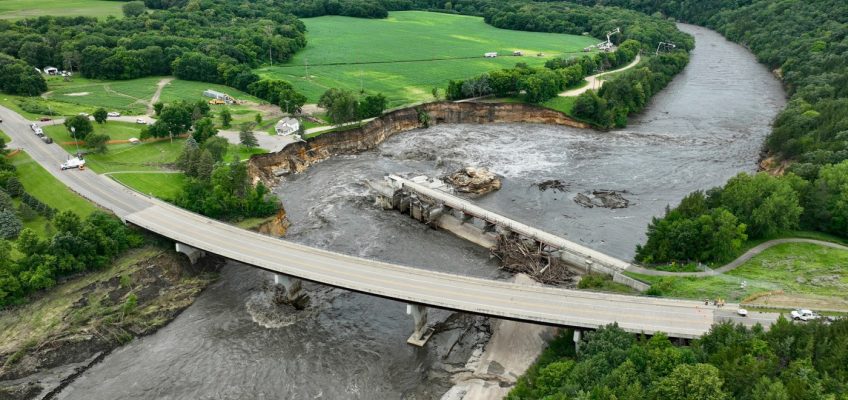The water quality in the Blue Earth River has deteriorated significantly since the Rapidan Dam in Rapidan, Minn., suffered a partial failure and sent nearly 12 million cubic yards of sediment behind the dam downriver and into the Minnesota River and eventually the Mississippi River.
“The Minnesota Pollution Control Agency has been monitoring water quality on the Blue Earth River below Rapidan Dam since 2007. Sediment, phosphorus, and nitrogen all increased dramatically with the dam’s partial failure,” Michael Rafferty, communications supervisor with the MPCA, told the Free Press.
Meanwhile, more scrutiny is focused on how the expanded farm field drainage systems have dramatically increased the flow of water into ravines, creeks and rivers.
Rafferty said that comparing Blue Earth River samples taken June 26, just after the dam failure, to the 2007-2021 long-term statistics, preliminarily show that the maximum pollution values were greatly exceeded.
Sediment was at 7,300 milligram per liter, compared to a previously measured maximum value of 1,400 mg/L.
Phosphorus levels were at 5.57 mg/L after the dam failure, compared to a previously measured maximum value of 1.36 mg/L.
And organic nitrogen was at 11.5 mg/L, compared to a previously measured maximum value of 4.8 mg/L.
Dissolved phosphorus and nitrate remained modest during the flooding and did not increase higher than the 2007-2021 maximum values, Rafferty said.
Sediment, phosphorus and organic nitrogen remained very elevated (above the 95th percentile) until early August and continued to be higher than the median well into fall.
“As of Nov. 11, 2024, the water clarity (as measured by a Secchi tube) still has not returned to expected values for this time of year.”
Carly Griffith, water program director at the Minnesota Center for Environmental Advocacy, said that while more severe storms and rainfalls make higher river flows more damaging, increased farm drainage tile systems put a lot more water into rivers quickly.
“An important part of the bigger picture is the increasing river flow and the flash increases. The hydrology from agriculture drainage needs to be part of the discussion.”
The flow of the Blue Earth and other rivers has increased and high, powerful flows are more frequent.
“(Farm) tile drainage has contributed 20% to 60% to that flow, according to many scientific studies,” Griffith said. “Artificial drainage has contributed more than (increased) precipitation.”
She said stream banks along area rivers hold a lot of sediment, more of which is being flushed into the rivers because of farm drainage that is eroding ravines and bluffs.
River and water-quality advocates have long said that storing more water on the landscape and letting it release more slowly, mimicking what marshes do, is one of the best ways to slow the damage to waterways.
More farm drainage systems in southern Minnesota are being upgraded because the current systems are old and because more rainfall makes it harder for the systems to remove water quickly from fields. When farmers apply to get a system upgraded, they can be required to add water storage.
“Water storage is really important, but it’s going to take a lot of investment,” Griffith said.
Related Articles
MnDOT to host public meetings, seek input for future railway systems plan
Minnesota DNR hits pause on NorthMet (PolyMet) copper-nickel mine permit review
Afton man racks up $44K in fines for beached St. Croix River boat
Red Lake tribal police officer among 2 killed in collision
Minnesota Court of Appeals to take up cannabis licensing dispute


Leave a Reply